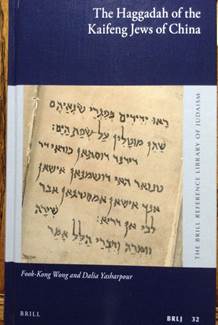The Haggadah of the Kaifeng Jews of China
by Fook-Kong Wong and Dalia Yasharpour
Leiden: Brill 2011. Hardcover. 216 pp.
Reviewed by Tiberiu Weisz

The Haggadah of the Kaifeng Jews of China (herein Haggadah) by Fook-Kong Wong, an Associate Professor at Hong Kong Theological Seminary, and Dalia Yasharpour, an Instructor of Persian language and literature at Harvard, is a scholarly study of the Hebrew Haggadah of the Kaifeng Jews.
The book is divided into five chapters. In addition, the book contains a short introduction, the reproduction of the Haggadah Hebrew text with extensive annotations, the English translation and the plates. The first five chapters would be of interest to the general reader and scholars alike, while the reproductions of the manuscripts would more likely be of interest to scholars and researchers.
The methodology follows a logical pattern. The authors state their objective "to analyze all the languages …and to gain an understanding of the Kaifeng Jews' liturgy as represented in their Passover Haggadah" (p. 5), followed by the body of the evidence. Often included are the authors' own observations, and each chapter ends with a short conclusion. The authors scrutinize every page, every sentence and every letter of the Haggadah; they analyze the handwriting, pinpointing similarities and differences in styles. They go over the vocalization and show "that they were produced locally rather than brought over from abroad" (p. 11). Another valuable inclusion is the side-by-side table of Hebrew words from the three manuscripts for comparison (pg. 13-16).
There are some inconsistencies and assumptions that the authors left unexplained. For example, the authors quoted from Gabriel Brotier that the Chinese scribes wrote with "sharpened bamboo-like quill pens…" (p. 8). Later on the authors quoted Israel Lehman, the curator of manuscripts of the Klau Library, Hebrew Union College that "both [manuscripts] appear to have been written with Chinese ink brush" (p.18). The authors provide no explanation to this inconsistency.
In another chapter the authors discuss at some length the "degree of Hebrew knowledge in the seventeenth and eighteenth centuries" of the Kaifeng Jews (p. 25). The authors quote a letter from Father Domenage who wrote in 1724 that "the Community had lost its tu-ching-pen" guide for studying the Bible. As a result "no one applied himself to the study of the Hebrew Bible by this time" (p. 30), and in the conclusion of the chapter the authors write "They had in possession a tu-ching-pen to assist them in reading the Bible" (pg 32). Again the inconsistency was not explained.
The authors make the assumption that "Apparently, they [Israelites] were traders because they mentioned that they came bearing western clothing" (p. 3). They paraphrased the original statement leaving out the word "tribute" without any further explanation.
Scholars will also wonder why the latest research and literature on the religious practices (including the Haggadah) of the Kaifeng Jews, were not included in the bibliography.
On the positive side, such inconsistencies and assumptions have not detracted from the value of this work. The authors have accomplished a monumental task: they have reconstructed a fragmented Hebrew text, clarified the misspelled Hebrew words, and explained the Chinese side notes, translated the text into English, and finally they have determined the origin of the liturgy of the Haggadah and the manuscripts. They conclude that the "archaic feature of the [Hebrew] language" pointed to a Passover liturgy of the Kaifeng community that originated in the Persian Passover rite (p. 63), and "the lack of additional songs in the Haggadah is once again consistent with the supposition that the source of the Haggadah is an early Babylonian tradition" (p. 75). The authors have achieved their goal.
To their credit, Wong and Yasharpour show that the Kaifeng Haggadah was an important primary source of Hebraic literature cherished by the Kaifeng Jews, and the authors have elevated an old Hebrew manuscript to an invaluable primary source for future studies.
Tiberiu Weisz has a Masters Degree in Chinese and is a scholar of China and Judaism. He is the author of two books: The Kaifeng Stone Inscriptions (2006) and The Covenant and the Mandate of Heaven (2008). His articles have been published in several countries. He has taught Classical and Modern Chinese, and is a translator from Chinese.
1. Dr. Fook-Kong Wong received his Th.D. from Harvard Divinity School and is an Associate Professor at Hong Kong Baptist Theological Seminary.
2. Dalia Yasharpour received her Ph.D. from the University of California, Los Angeles and teaches Persian at Harvard.
